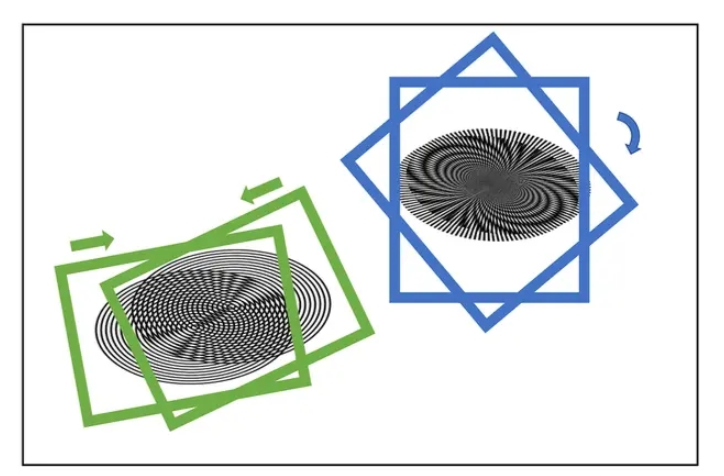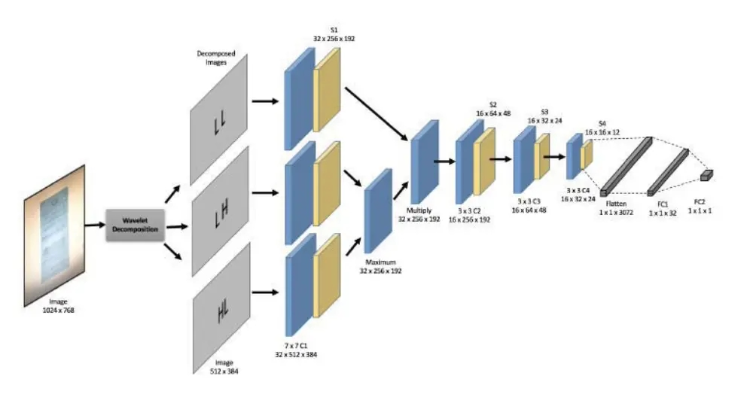今天小编给大家分享一下怎么用python代码实现图片去摩尔纹的相关知识点,内容详细,逻辑清晰,相信大部分人都还太了解这方面的知识,所以分享这篇文章给大家参考一下,希望大家阅读完这篇文章后有所收获,下面我们一起来了解一下吧。
当感光元件像素的空间频率与影像中条纹的空间频率接近时,可能产生一种新的波浪形的干扰图案,即所谓的摩尔纹。传感器的网格状纹理构成了一个这样的图案。当图案中的细条状结构与传感器的结构以小角度交叉时,这种效应也会在图像中产生明显的干扰。这种现象在一些细密纹理情况下,比如时尚摄影中的布料上,非常普遍。这种摩尔纹可能通过亮度也可能通过颜色来展现。但是在这里,仅针对在翻拍过程中产生的图像摩尔纹进行处理。
翻拍即从计算机屏幕上捕获图片,或对着屏幕拍摄图片;该方式会在图片上产生摩尔纹现象

论文主要处理思路
对原图作Haar变换得到四个下采样特征图(原图下二采样cA、Horizontal横向高频cH、Vertical纵向高频cV、Diagonal斜向高频cD)
然后分别利用四个独立的CNN对四个下采样特征图卷积池化,提取特征信息
原文随后对三个高频信息卷积池化后的结果的每个channel、每个像素点比对,取max
将上一步得到的结果和cA卷积池化后的结果作笛卡尔积
论文地址
  如下图所示,本项目复现了论文的图像去摩尔纹方法,并对数据处理部分进行了修改,并且网络结构上也参考了源码中的结构,对图片产生四个下采样特征图,而不是论文中的三个,具体处理方式大家可以参考一下网络结构。

import math import paddle import paddle.nn as nn import paddle.nn.functional as F # import pywt from paddle.nn import Linear, Dropout, ReLU from paddle.nn import Conv2D, MaxPool2D class mcnn(nn.Layer): def __init__(self, num_classes=1000): super(mcnn, self).__init__() self.num_classes = num_classes self._conv1_LL = Conv2D(3,32,7,stride=2,padding=1,) # self.bn1_LL = nn.BatchNorm2D(128) self._conv1_LH = Conv2D(3,32,7,stride=2,padding=1,) # self.bn1_LH = nn.BatchNorm2D(256) self._conv1_HL = Conv2D(3,32,7,stride=2,padding=1,) # self.bn1_HL = nn.BatchNorm2D(512) self._conv1_HH = Conv2D(3,32,7,stride=2,padding=1,) # self.bn1_HH = nn.BatchNorm2D(256) self.pool_1_LL = nn.MaxPool2D(kernel_size=2,stride=2, padding=0) self.pool_1_LH = nn.MaxPool2D(kernel_size=2,stride=2, padding=0) self.pool_1_HL = nn.MaxPool2D(kernel_size=2,stride=2, padding=0) self.pool_1_HH = nn.MaxPool2D(kernel_size=2,stride=2, padding=0) self._conv2 = Conv2D(32,16,3,stride=2,padding=1,) self.pool_2 = nn.MaxPool2D(kernel_size=2,stride=2, padding=0) self.dropout2 = Dropout(p=0.5) self._conv3 = Conv2D(16,32,3,stride=2,padding=1,) self.pool_3 = nn.MaxPool2D(kernel_size=2,stride=2, padding=0) self._conv4 = Conv2D(32,32,3,stride=2,padding=1,) self.pool_4 = nn.MaxPool2D(kernel_size=2,stride=2, padding=0) self.dropout4 = Dropout(p=0.5) # self.bn1_HH = nn.BatchNorm1D(256) self._fc1 = Linear(in_features=64,out_features=num_classes) self.dropout5 = Dropout(p=0.5) self._fc2 = Linear(in_features=2,out_features=num_classes) def forward(self, inputs1, inputs2, inputs3, inputs4): x1_LL = self._conv1_LL(inputs1) x1_LL = F.relu(x1_LL) x1_LH = self._conv1_LH(inputs2) x1_LH = F.relu(x1_LH) x1_HL = self._conv1_HL(inputs3) x1_HL = F.relu(x1_HL) x1_HH = self._conv1_HH(inputs4) x1_HH = F.relu(x1_HH) pool_x1_LL = self.pool_1_LL(x1_LL) pool_x1_LH = self.pool_1_LH(x1_LH) pool_x1_HL = self.pool_1_HL(x1_HL) pool_x1_HH = self.pool_1_HH(x1_HH) temp = paddle.maximum(pool_x1_LH, pool_x1_HL) avg_LH_HL_HH = paddle.maximum(temp, pool_x1_HH) inp_merged = paddle.multiply(pool_x1_LL, avg_LH_HL_HH) x2 = self._conv2(inp_merged) x2 = F.relu(x2) x2 = self.pool_2(x2) x2 = self.dropout2(x2) x3 = self._conv3(x2) x3 = F.relu(x3) x3 = self.pool_3(x3) x4 = self._conv4(x3) x4 = F.relu(x4) x4 = self.pool_4(x4) x4 = self.dropout4(x4) x4 = paddle.flatten(x4, start_axis=1, stop_axis=-1) x5 = self._fc1(x4) x5 = self.dropout5(x5) out = self._fc2(x5) return out model_res = mcnn(num_classes=2) paddle.summary(model_res,[(1,3,512,384),(1,3,512,384),(1,3,512,384),(1,3,512,384)])
---------------------------------------------------------------------------
Layer (type) Input Shape Output Shape Param #
===========================================================================
Conv2D-1 [[1, 3, 512, 384]] [1, 32, 254, 190] 4,736
Conv2D-2 [[1, 3, 512, 384]] [1, 32, 254, 190] 4,736
Conv2D-3 [[1, 3, 512, 384]] [1, 32, 254, 190] 4,736
Conv2D-4 [[1, 3, 512, 384]] [1, 32, 254, 190] 4,736
MaxPool2D-1 [[1, 32, 254, 190]] [1, 32, 127, 95] 0
MaxPool2D-2 [[1, 32, 254, 190]] [1, 32, 127, 95] 0
MaxPool2D-3 [[1, 32, 254, 190]] [1, 32, 127, 95] 0
MaxPool2D-4 [[1, 32, 254, 190]] [1, 32, 127, 95] 0
Conv2D-5 [[1, 32, 127, 95]] [1, 16, 64, 48] 4,624
MaxPool2D-5 [[1, 16, 64, 48]] [1, 16, 32, 24] 0
Dropout-1 [[1, 16, 32, 24]] [1, 16, 32, 24] 0
Conv2D-6 [[1, 16, 32, 24]] [1, 32, 16, 12] 4,640
MaxPool2D-6 [[1, 32, 16, 12]] [1, 32, 8, 6] 0
Conv2D-7 [[1, 32, 8, 6]] [1, 32, 4, 3] 9,248
MaxPool2D-7 [[1, 32, 4, 3]] [1, 32, 2, 1] 0
Dropout-2 [[1, 32, 2, 1]] [1, 32, 2, 1] 0
Linear-1 [[1, 64]] [1, 2] 130
Dropout-3 [[1, 2]] [1, 2] 0
Linear-2 [[1, 2]] [1, 2] 6
===========================================================================
Total params: 37,592
Trainable params: 37,592
Non-trainable params: 0
---------------------------------------------------------------------------
Input size (MB): 9.00
Forward/backward pass size (MB): 59.54
Params size (MB): 0.14
Estimated Total Size (MB): 68.68
---------------------------------------------------------------------------
{'total_params': 37592, 'trainable_params': 37592}  与源代码不同的是,本项目将图像的小波分解部分集成在了数据读取部分,即改为了线上进行小波分解,而不是源代码中的线下进行小波分解并且保存图片。首先,定义小波分解的函数
!pip install PyWavelets
import numpy as np import pywt def splitFreqBands(img, levRows, levCols): halfRow = int(levRows/2) halfCol = int(levCols/2) LL = img[0:halfRow, 0:halfCol] LH = img[0:halfRow, halfCol:levCols] HL = img[halfRow:levRows, 0:halfCol] HH = img[halfRow:levRows, halfCol:levCols] return LL, LH, HL, HH def haarDWT1D(data, length): avg0 = 0.5; avg1 = 0.5; dif0 = 0.5; dif1 = -0.5; temp = np.empty_like(data) # temp = temp.astype(float) temp = temp.astype(np.uint8) h = int(length/2) for i in range(h): k = i*2 temp[i] = data[k] * avg0 + data[k + 1] * avg1; temp[i + h] = data[k] * dif0 + data[k + 1] * dif1; data[:] = temp # computes the homography coefficients for PIL.Image.transform using point correspondences def fwdHaarDWT2D(img): img = np.array(img) levRows = img.shape[0]; levCols = img.shape[1]; # img = img.astype(float) img = img.astype(np.uint8) for i in range(levRows): row = img[i,:] haarDWT1D(row, levCols) img[i,:] = row for j in range(levCols): col = img[:,j] haarDWT1D(col, levRows) img[:,j] = col return splitFreqBands(img, levRows, levCols)
!cd "data/data188843/" && unzip -q 'total_images.zip'
import os
recapture_keys = [ 'ValidationMoire']
original_keys = ['ValidationClear']
def get_image_label_from_folder_name(folder_name):
"""
:param folder_name:
:return:
"""
for key in original_keys:
if key in folder_name:
return 'original'
for key in recapture_keys:
if key in folder_name:
return 'recapture'
return 'unclear'
label_name2label_id = {
'original': 0,
'recapture': 1,}
src_image_dir = "data/data188843/total_images"
dst_file = "data/data188843/total_images/train.txt"
image_folder = [file for file in os.listdir(src_image_dir)]
print(image_folder)
image_anno_list = []
for folder in image_folder:
label_name = get_image_label_from_folder_name(folder)
# label_id = label_name2label_id.get(label_name, 0)
label_id = label_name2label_id[label_name]
folder_path = os.path.join(src_image_dir, folder)
image_file_list = [file for file in os.listdir(folder_path) if
file.endswith('.jpg') or file.endswith('.jpeg') or
file.endswith('.JPG') or file.endswith('.JPEG') or file.endswith('.png')]
for image_file in image_file_list:
# if need_root_dir:
# image_path = os.path.join(folder_path, image_file)
# else:
image_path = image_file
image_anno_list.append(folder +"/"+image_path +"\t"+ str(label_id) + '\n')
dst_path = os.path.dirname(src_image_dir)
if not os.path.exists(dst_path):
os.makedirs(dst_path)
with open(dst_file, 'w') as fd:
fd.writelines(image_anno_list)import paddle
import numpy as np
import pandas as pd
import PIL.Image as Image
from paddle.vision import transforms
# from haar2D import fwdHaarDWT2D
paddle.disable_static()
# 定义数据预处理
data_transforms = transforms.Compose([
transforms.Resize(size=(448,448)),
transforms.ToTensor(), # transpose操作 + (img / 255)
# transforms.Normalize( # 减均值 除标准差
# mean=[0.31169346, 0.25506335, 0.12432463],
# std=[0.34042713, 0.29819837, 0.1375536])
#计算过程:output[channel] = (input[channel] - mean[channel]) / std[channel]
])
# 构建Dataset
class MyDataset(paddle.io.Dataset):
"""
步骤一:继承paddle.io.Dataset类
"""
def __init__(self, train_img_list, val_img_list, train_label_list, val_label_list, mode='train', ):
"""
步骤二:实现构造函数,定义数据读取方式,划分训练和测试数据集
"""
super(MyDataset, self).__init__()
self.img = []
self.label = []
# 借助pandas读csv的库
self.train_images = train_img_list
self.test_images = val_img_list
self.train_label = train_label_list
self.test_label = val_label_list
if mode == 'train':
# 读train_images的数据
for img,la in zip(self.train_images, self.train_label):
self.img.append('/home/aistudio/data/data188843/total_images/'+img)
self.label.append(paddle.to_tensor(int(la), dtype='int64'))
else:
# 读test_images的数据
for img,la in zip(self.test_images, self.test_label):
self.img.append('/home/aistudio/data/data188843/total_images/'+img)
self.label.append(paddle.to_tensor(int(la), dtype='int64'))
def load_img(self, image_path):
# 实际使用时使用Pillow相关库进行图片读取即可,这里我们对数据先做个模拟
image = Image.open(image_path).convert('RGB')
# image = data_transforms(image)
return image
def __getitem__(self, index):
"""
步骤三:实现__getitem__方法,定义指定index时如何获取数据,并返回单条数据(训练数据,对应的标签)
"""
image = self.load_img(self.img[index])
LL, LH, HL, HH = fwdHaarDWT2D(image)
label = self.label[index]
# print(LL.shape)
# print(LH.shape)
# print(HL.shape)
# print(HH.shape)
LL = data_transforms(LL)
LH = data_transforms(LH)
HL = data_transforms(HL)
HH = data_transforms(HH)
print(type(LL))
print(LL.dtype)
return LL, LH, HL, HH, np.array(label, dtype='int64')
def __len__(self):
"""
步骤四:实现__len__方法,返回数据集总数目
"""
return len(self.img)
image_file_txt = '/home/aistudio/data/data188843/total_images/train.txt'
with open(image_file_txt) as fd:
lines = fd.readlines()
train_img_list = list()
train_label_list = list()
for line in lines:
split_list = line.strip().split()
image_name, label_id = split_list
train_img_list.append(image_name)
train_label_list.append(label_id)
# print(train_img_list)
# print(train_label_list)
# 测试定义的数据集
train_dataset = MyDataset(mode='train',train_label_list=train_label_list, train_img_list=train_img_list, val_img_list=train_img_list, val_label_list=train_label_list)
# test_dataset = MyDataset(mode='test')
# 构建训练集数据加载器
train_loader = paddle.io.DataLoader(train_dataset, batch_size=2, shuffle=True)
# 构建测试集数据加载器
valid_loader = paddle.io.DataLoader(train_dataset, batch_size=2, shuffle=True)
print('=============train dataset=============')
for LL, LH, HL, HH, label in train_dataset:
print('label: {}'.format(label))
breakmodel2 = paddle.Model(model_res) model2.prepare(optimizer=paddle.optimizer.Adam(parameters=model2.parameters()), loss=nn.CrossEntropyLoss(), metrics=paddle.metric.Accuracy()) model2.fit(train_loader, valid_loader, epochs=5, verbose=1, )
以上就是“怎么用python代码实现图片去摩尔纹”这篇文章的所有内容,感谢各位的阅读!相信大家阅读完这篇文章都有很大的收获,小编每天都会为大家更新不同的知识,如果还想学习更多的知识,请关注亿速云行业资讯频道。
免责声明:本站发布的内容(图片、视频和文字)以原创、转载和分享为主,文章观点不代表本网站立场,如果涉及侵权请联系站长邮箱:is@yisu.com进行举报,并提供相关证据,一经查实,将立刻删除涉嫌侵权内容。